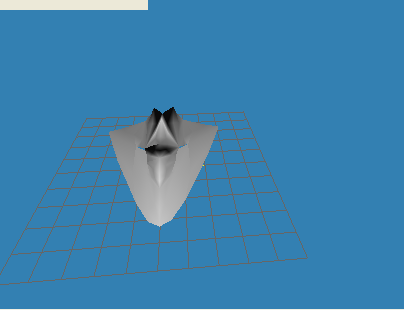At heart, the game is intended to be a futuristic racer. The vehicles are hovercraft (though using anti-gravity rather than an air cusion), but, like an airplane, also have wings, flaps, and a rudder. Though unable to "fly," drivers of the vechiles use the airplane-like features to steer the craft. They can bank the craft left or right, or adjust the yaw of the craft with the rudder.
Most levels will be basic races, but they will be much more open-ended than a traditional race on a traditional track. With hovercraft ability, the problem of rough terrain at high speeds is eliminated, so the course will be more of an orienteering race style--drivers are required to simply pass a number of checkpoints in order to complete a lap. The course itself is simply a large terrain map with varing heights. Optimal routes will not be as clearly marked as they would be in a road race.
We'd also like to keep the game open-ended enough to allow for additional types of missions, hopefully being able to fit them into a broader story of the game. In that case, a level would consist of a number of mission objectives (make it to this point, destroy a craft, etc...).
Anti-gravity, orignially developed as a tool by military research, works by forcing away matter. The military orignially used the technology in battlefield applications in rough-terrain conditions. By mounting these anti-gravity devices on the bottom of ground vehicles, a vehicle could be levitated, permitting travel no matter what the underlying terrain looked like (very rocky, muddy, or even liquid). Its usefullness in battle was immersurable--the vehicles could be quick and travel over any terrain. The traditional large treads of the battle tank quickly became obsolete.
These vehicles did have one flaw, however. Having no contact with the ground, the only form of movement for the vehicles air propultion. Jet engines quickly became the source of thrust, but they introduced a new problem--intertia. To stop the vehicles, the driver had to reverse the direction of the ship and fire the engine against the direction of travel. Not only was this awkward, but it prevented the craft from stopping quickly or making any advanced manuvers.
As a solution, a page was taken from the history of the jet fighter, and hover vehicles soon began sporting wings and tails, enabling the crafts to turn and brake without reorienting. With their new usefulness, popularity of these hovercrafts grew and soon were employed outside of the military. These crafts began flying people and goods across the country and over oceans. The era of the automobile was coming to an end as cheap, fast hover transportation was replacing planes in the sky, boats on the water, and cars on the road.
But from the dying tradition of the automobile grew a new movement. As the musclecars of earlier generations began to collect dust, a new geration of hobbyists and tinkerers began work on their new creation--hovering speeders, built to scream over the desert floor at hundreds of kilometers an hour. Working with scraps in garages, these new pioneers raced their creations over the wide spaces of the old American West...
What are the rules of the game
Most levels will be a straight race between checkpoints. The player will pilot his or her craft and the fastest time wins. There will be damage on the ships, as well as limited weaponry.
As stated before, some levels may vary from this race format, especially if necessary for the story or plot of the game.
What can the player do
Within the bounds of the physics model described below, the player will simply be racing his vehicle. The controls, however, are quite odd. As the ship is a cross between a plane and a hovercraft, turning and jumping will be quite different than any other car racer. The player's directional buttons will control the pitch and roll, but a separate pair will control the rudder.
Most stages will be pure races. Because of the open-endedness of the levels, races will be between checkpoints.
What does the AI/Physics do?
 | The physics are somewhat unique for the vehicle. As a hovercraft, it uses thrust to propell itself forward. Naturally, this will induce drag (which isn't a simple constant times speed--it depends on the orientation of the craft. We'll likley only tie it into pitch). As the craft has wings, velocity through the air will produce limited lift, which will also be dependent on speed and pitch. We've already discussed the vehicle's hovering ability. The force upwards on the craft will be inversely proportional to the distance from the ground. AI should be quite simple. Computer-controlled crafts will only need to find their way between the different checkpoints, which should be pretty easy. We may need to make some system to define "subcheckpoints" on the map so that computer players will follow a reasonable path and not just the shortest. We could also do something similar with height map calculations. AI players also will need to have some knowledge of how to operate and when to use weapons. |
What will the environment look like?
The environment is intended to be wide open terrain. It fits with the physics model well, and we can easily manipulate a height map. We can also use image editors to make levels.What plans do you have for saving/loading/setting parameters?
We can store parameters in a simple text file. We want to be able to save basic preferences and note which levels a player has completed or unlocked.Models so far...



